Influence of Flow Velocity on Tsunami Loss Estimation
Abstract
:1. Introduction
2. Materials and Methods
2.1. Tsunami Hazard Modelling
2.2. Bivariate-IM Tsunami Loss Estimation
2.3. Influence of Flow Velocity on Tsunami Loss
3. Results and Discussion
3.1. Sendai
3.2. Onagawa
4. Conclusions
- Tsunami losses of both Sendai on plain coast and Onagawa on ria coast are highly sensitive to DEM resolution. In addition, 50-m DEM gives 20% more loss for Sendai and 20% less loss in Onagawa than 10-m DEM. DEM of coarse resolution is unable to realistically reflect the gradually decaying tsunami waves over inland and the change of land elevation.
- For both plain and ria coasts, RC buildings are the most sensitive structure type to flow velocity, followed by steel and masonry. Wood structures are not sensitive to consideration of velocity for tsunami loss estimation.
- The importance of flow velocity for tsunami mainly depends on the inundation depth and flow velocity combinations at buildings’ locations. Velocity is more important for buildings located close to the sea (e.g., less than 1 km). The influence of velocity for total tsunami loss at a municipal or community scale, depends on the locations of buildings, the main structural types, topography, land elevation, and inundation scale. For buildings located close to the sea affected by a small tsunami and buildings located farther from the shoreline affected by a destructive tsunami, flow velocity may be important for more accurate loss estimation, but for buildings close to the sea due to a destructive tsunami, flow velocity may not be important. However, for a 9.0 Tohoku-type tsunami, loss estimation for buildings located very close to the sea is more likely to be influenced by the inclusion of flow velocity.
Supplementary Materials
Acknowledgments
Author Contributions
Conflicts of Interest
Abbreviations
| DEM | Digital Elevation Model |
| MLIT | Ministry of Land, Infrastructure, and Transportation |
| h | Inundation depth |
| v | Flow velocity |
| Momentum flux | |
| MLE | Maximum likelihood estimation |
References
- Mitchell-Wallace, K.; Foote, M.; Jones, M.; Hillier, J. Natural Catastrophe Risk Management and Modelling: A Practitioner’s Guide; John Wiley & Sons: Hoboken, NJ, USA, 2017. [Google Scholar]
- Lakdawalla, D.; Zanjani, G. Catastrophe bonds, reinsurance, and the optimal collateralization of risk transfer. J. Risk Insur. 2012, 79, 449–476. [Google Scholar] [CrossRef]
- Gibson, R.; Habib, M.A.; Ziegler, A. Reinsurance or securitization: The case of natural catastrophe risk. J. Math. Econ. 2014, 53, 79–100. [Google Scholar] [CrossRef] [Green Version]
- Yoshikawa, H.; Goda, K. Financial seismic risk analysis of building portfolios. Nat. Hazards Rev. 2013, 15, 112–120. [Google Scholar] [CrossRef]
- Hagendorff, B.; Hagendorff, J.; Keasey, K.; Gonzalez, A. The risk implications of insurance securitization: The case of catastrophe bonds. J. Corp. Financ. 2014, 25, 387–402. [Google Scholar] [CrossRef] [Green Version]
- Goda, K. Seismic risk management of insurance portfolio using catastrophe bonds. Comput. Civ. Infrastruct. Eng. 2015, 30, 570–582. [Google Scholar] [CrossRef]
- Park, H.; Cox, D.T.; Barbosa, A.R. Comparison of inundation depth and momentum flux based fragilities for probabilistic tsunami damage assessment and uncertainty analysis. Coast. Eng. 2017, 122, 10–26. [Google Scholar] [CrossRef]
- Macabuag, J.; Rossetto, T.; Ioannou, I.; Suppasri, A.; Sugawara, D.; Adriano, B.; Imamura, F.; Eames, I.; Koshimura, S. A proposed methodology for deriving tsunami fragility functions for buildings using optimum intensity measures. Nat. Hazards 2016, 84, 1257–1285. [Google Scholar] [CrossRef]
- Suppasri, A.; Mas, E.; Charvet, I.; Gunasekera, R.; Imai, K.; Fukutani, Y.; Abe, Y.; Imamura, F. Building damage characteristics based on surveyed data and fragility curves of the 2011 Great East Japan tsunami. Nat. Hazards 2013, 66, 319–341. [Google Scholar] [CrossRef]
- Charvet, I.; Ioannou, I.; Rossetto, T.; Suppasri, A.; Imamura, F. Empirical fragility assessment of buildings affected by the 2011 Great East Japan tsunami using improved statistical models. Nat. Hazards 2014, 73, 951–973. [Google Scholar] [CrossRef]
- Narita, Y.; Koshimura, S. Classification of tsunami fragility curves based on regional characteristics of tsunami damage. J. Jpn. Soc. Civ. Eng. Ser. B2 Coast. Eng. 2015, 71, I_331–I_336. (In Japnese) [Google Scholar] [CrossRef]
- De Risi, R.; Goda, K.; Mori, N.; Yasuda, T. Bayesian tsunami fragility modeling considering input data uncertainty. Stoch. Environ. Res. Risk Assess. 2017, 31, 1253–1269. [Google Scholar] [CrossRef]
- Yeh, H.; Sato, S.; Tajima, Y. The 11 March 2011 East Japan earthquake and tsunami: Tsunami effects on coastal infrastructure and buildings. Pure Appl. Geophys. 2013, 170, 1019–1031. [Google Scholar] [CrossRef]
- Yeh, H.; Barbosa, A.R.; Ko, H.; Cawley, J. Tsunami loadings on structures: Review and analysis. Coast. Eng. Proc. 2014, 1, 1–13. [Google Scholar] [CrossRef]
- Fritz, H.; Borrero, J.; Synolakis, C.; Yoo, J. 2004 Indian Ocean tsunami flow velocity measurements from survivor videos. Geophys. Res. Lett. 2006, 33. [Google Scholar] [CrossRef]
- Hayashi, S.; Koshimura, S. The 2011 Tohoku tsunami flow velocity estimation by the aerial video analysis and numerical modeling. J. Disaster Res. 2013, 8, 561–572. [Google Scholar] [CrossRef]
- Lipa, B.; Isaacson, J.; Nyden, B.; Barrick, D. Tsunami arrival detection with high frequency (HF) radar. Remote Sens. 2012, 4, 1448–1461. [Google Scholar] [CrossRef]
- Song, Y.T.; Fukumori, I.; Shum, C.K.; Yi, Y. Merging tsunamis of the 2011 Tohoku-Oki earthquake detected over the open ocean. Geophys. Res. Lett. 2012, 39. [Google Scholar] [CrossRef]
- Charvet, I.; Suppasri, A.; Kimura, H.; Sugawara, D.; Imamura, F. A multivariate generalized linear tsunami fragility model for Kesennuma City based on maximum flow depths, velocities and debris impact, with evaluation of predictive accuracy. Nat. Hazards 2015, 79, 2073–2099. [Google Scholar] [CrossRef]
- Koshimura, S.; Oie, T.; Yanagisawa, H.; Imamura, F. Developing fragility functions for tsunami damage estimation using numerical model and post-tsunami data from Banda Aceh, Indonesia. Coast. Eng. J. 2009, 51, 243–273. [Google Scholar] [CrossRef]
- Maruyama, Y.; Kitamura, K.; Yamazaki, F. Tsunami damage assessment of buildings in Chiba Prefecture, Japan using fragility function developed after the 2011 Tohoku-Oki Earthquake. In Safety, Reliability, Risk and Life-Cycle Performance of Structures and Infrastructures; Taylor & Francis Group: London, UK, 2013; pp. 4237–4244. [Google Scholar]
- Tanaka, N.; Onai, A.; Kondo, K. Fragility curve of different damage of wooden building due to tsunami based on tsunami fluid force and its moment. J. Jpn. Soc. Civ. Eng. Coast. Eng. 2015, 71, 1–11. [Google Scholar] [CrossRef]
- Park, H.; Cox, D.T. Probabilistic assessment of near-field tsunami hazards: Inundation depth, velocity, momentum flux, arrival time, and duration applied to Seaside, Oregon. Coast. Eng. 2016, 117, 79–96. [Google Scholar] [CrossRef]
- González-Riancho, P.; Aguirre-Ayerbe, I.; García-Aguilar, O.; Medina, R.; González, M.; Aniel-Quiroga, I.; Gutiérrez, O.Q.; Álvarez-Gómez, J.A.; Larreynaga, J.; Gavidia, F. Integrated tsunami vulnerability and risk assessment: Application to the coastal area of El Salvador. Nat. Hazards Earth Syst. Sci. 2014, 14, 1223–1244. [Google Scholar] [CrossRef] [Green Version]
- Schneider, B.; Hoffmann, G.; Reicherter, K. Scenario-based tsunami risk assessment using a static flooding approach and high-resolution digital elevation data: An example from Muscat in Oman. Glob. Planet. Chang. 2016, 139, 183–194. [Google Scholar] [CrossRef]
- Browning, J.; Thomas, N. An assessment of the tsunami risk in Muscat and Salalah, Oman, based on estimations of probable maximum loss. Int. J. Disaster Risk Reduct. 2016, 16, 75–87. [Google Scholar] [CrossRef]
- Okumura, N.; Jonkman, S.N.; Esteban, M.; Hofland, B.; Shibayama, T. A method for tsunami risk assessment: A case study for Kamakura, Japan. Nat. Hazards 2017, 88, 1451–1472. [Google Scholar] [CrossRef]
- Goda, K.; Mai, P.M.; Yasuda, T.; Mori, N. Sensitivity of tsunami wave profiles and inundation simulations to earthquake slip and fault geometry for the 2011 Tohoku earthquake. Earth Planets Space 2014, 66, 1–20. [Google Scholar] [CrossRef] [Green Version]
- Mueller, C.; Power, W.; Fraser, S.; Wang, X. Effects of rupture complexity on local tsunami inundation: Implications for probabilistic tsunami hazard assessment by example. J. Geophys. Res. Solid Earth 2015, 120, 488–502. [Google Scholar] [CrossRef]
- Goda, K.; Abilova, K. Tsunami hazard warning and risk prediction based on inaccurate earthquake source parameters. Nat. Hazards Earth Syst. Sci. 2016, 16, 577–593. [Google Scholar] [CrossRef]
- Goda, K.; Song, J. Uncertainty modeling and visualization for tsunami hazard and risk mapping: A case study for the 2011 Tohoku earthquake. Stoch. Environ. Res. Risk Assess. 2016, 30, 2271–2285. [Google Scholar] [CrossRef] [Green Version]
- Jaimes, M.A.; Reinoso, E.; Ordaz, M.; Huerta, B.; Silva, R.; Mendoza, E.; Rodríguez, J.C. A new approach to probabilistic earthquake-induced tsunami risk assessment. Ocean Coast. Manag. 2016, 119, 68–75. [Google Scholar] [CrossRef]
- Goda, K.; Yasuda, T.; Mori, N.; Maruyama, T. New Scaling Relationships of Earthquake Source Parameters for Stochastic Tsunami Simulations. Coast. Eng. J. 2016, 58, 1–40. [Google Scholar] [CrossRef]
- Murotani, S.; Satake, K.; Fujii, Y. Scaling relations of seismic moment, rupture area, average slip, and asperity size for M9 subduction-zone earthquakes. Geophys. Res. Lett. 2013, 40, 5070–5074. [Google Scholar] [CrossRef]
- Petrone, C.; Rossetto, T.; Goda, K. Fragility assessment of a RC structure under tsunami actions via nonlinear static and dynamic analyses. Eng. Struct. 2017, 136, 36–53. [Google Scholar] [CrossRef]
- Goto, C.; Ogawa, Y.; Shuto, N. IUGG/IOC Time Project: Numerical Method of Tsunami Simulation with the Leap-Frog Scheme; IOC Manuals and Guides No. 35; UNESCO: Paris, France, 1997. [Google Scholar]
- De Risi, R.; Goda, K.; Yasuda, T.; Mori, N. Is flow velocity important in tsunami empirical fragility modeling? Earth-Sci. Rev. 2017, 166, 64–82. [Google Scholar] [CrossRef]
- Mai, P.M.; Beroza, G.C. A spatial random field model to characterize complexity in earthquake slip. J. Geophys. Res. Solid Earth 2002, 107. [Google Scholar] [CrossRef]
- Mai, P.M.; Thingbaijam, K.K.S. SRCMOD: An online database of finite-fault rupture models. Seismol. Res. Lett. 2014, 85, 1348–1357. [Google Scholar] [CrossRef]
- Satake, K.; Fujii, Y.; Harada, T.; Namegaya, Y. Time and space distribution of coseismic slip of the 2011 Tohoku earthquake as inferred from tsunami waveform data. Bull. Seismol. Soc. Am. 2013, 103, 1473–1492. [Google Scholar] [CrossRef]
- Ministry of Land, Infrastructure and Transportation (MLIT). Survey of Tsunami Damage Condition. Available online: http://www.mlit.go.jp/toshi/toshi-hukkou-arkaibu.html (accessed on 1 July 2014).
- De Risi, R.; Goda, K. Probabilistic earthquake–tsunami multi-hazard analysis: Application to the Tohoku region, Japan. Front. Built Environ. 2016, 2. [Google Scholar] [CrossRef]
- Hosmer, D.W.; Lemeshow, S.; Sturdivant, R.X. Applied Logistic Regression; John Wiley & Sons: Hoboken, NJ, USA, 2013. [Google Scholar]
- Construction Research Institute. Japan Building Cost Information; Construction Research Institute: Tokyo, Japan, 2011. [Google Scholar]
- Ministry of Land, Infrastructure and Transportation (MLIT). Available online: http://www.mlit.go.jp/toukeijouhou/chojou/stat-e.htm (accessed on 1 July 2014).
- Latcharote, P.; Suppasri, A.; Yamashita, A.; Adriano, B.; Koshimura, S.; Kai, Y.; Imamura, F. Possible failure mechanism of buildings overturned during the 2011 Great East Japan tsunami in the town of Onagawa. Front. Built Environ. 2017, 3, 1–18. [Google Scholar] [CrossRef]
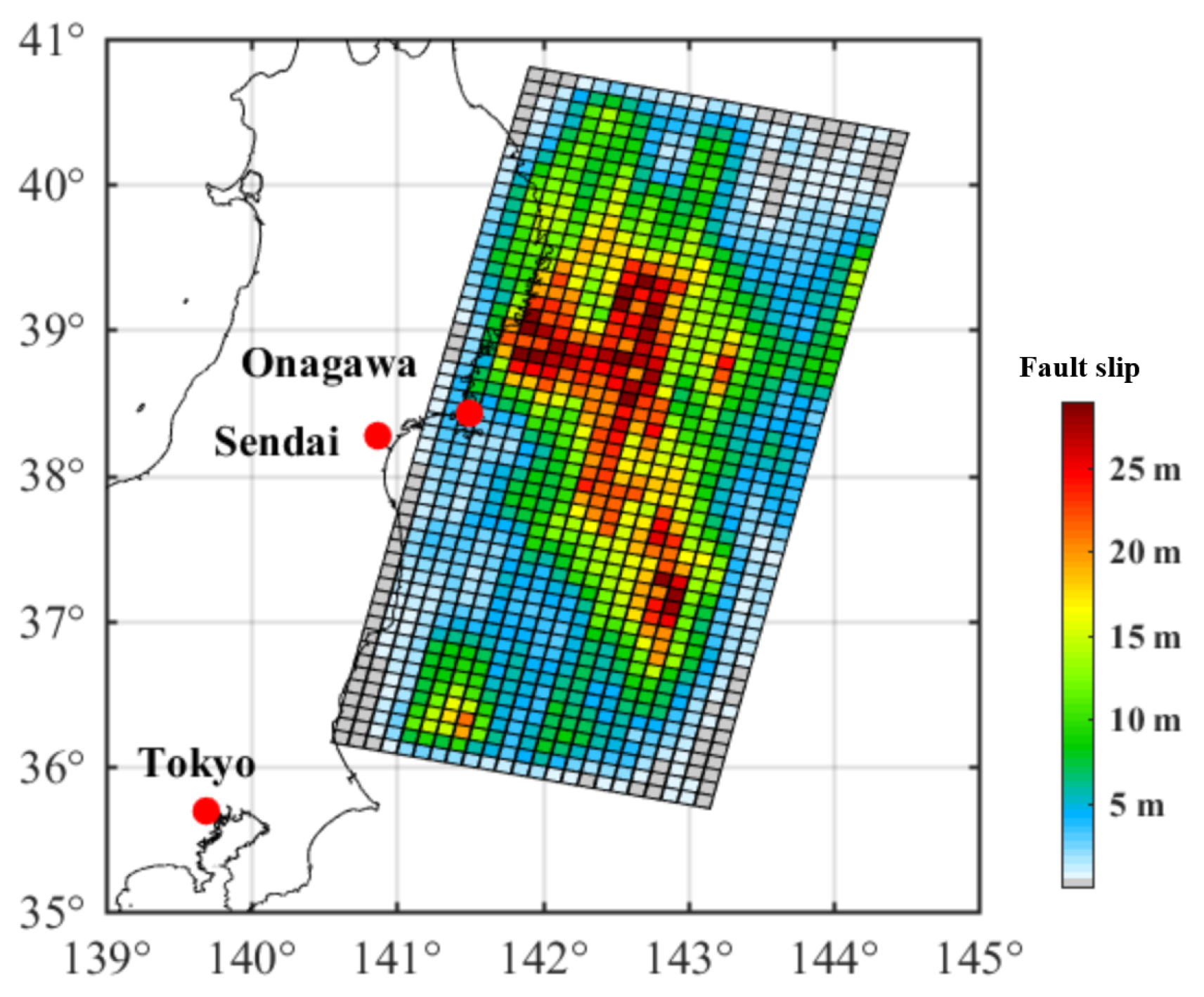
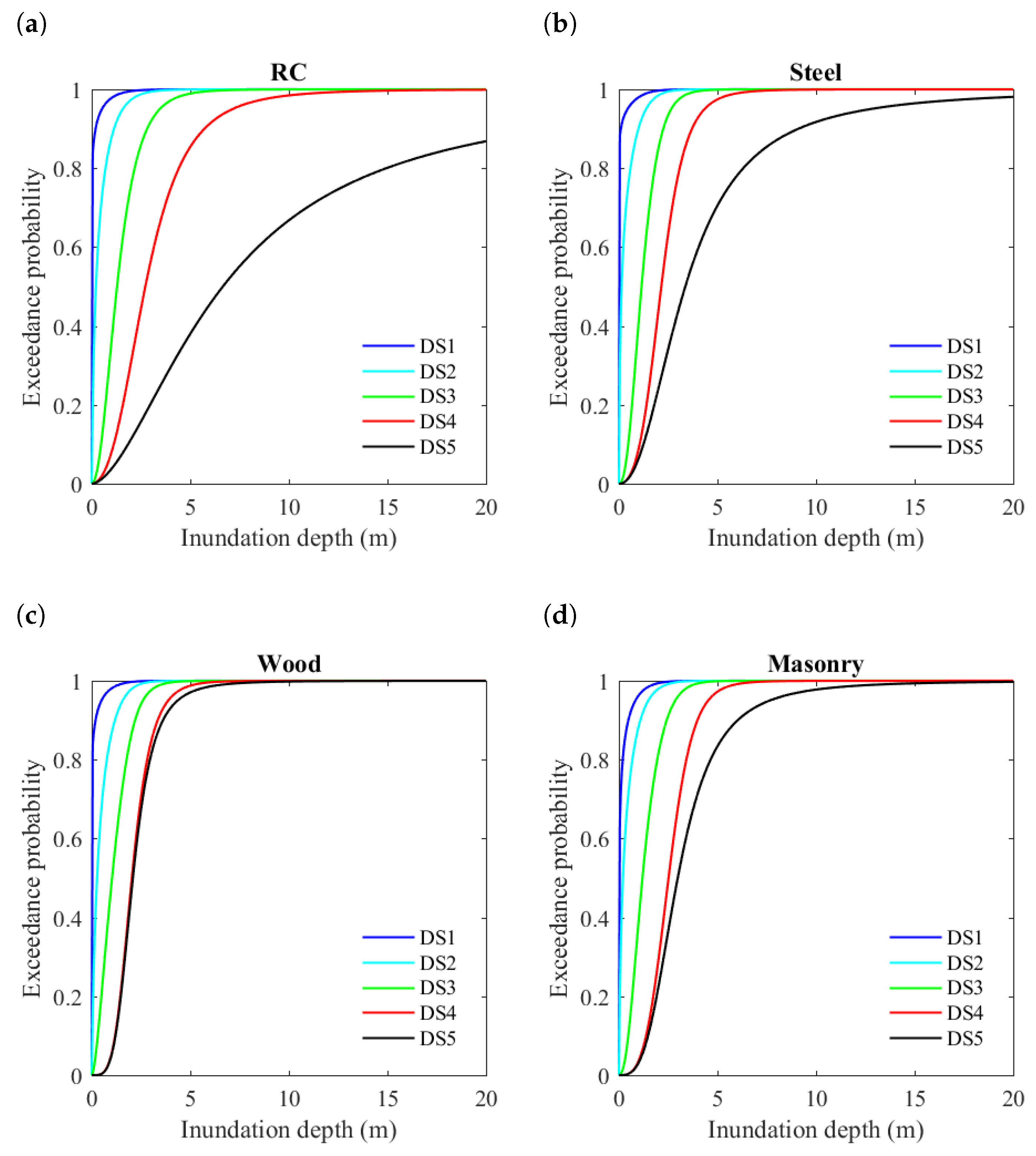
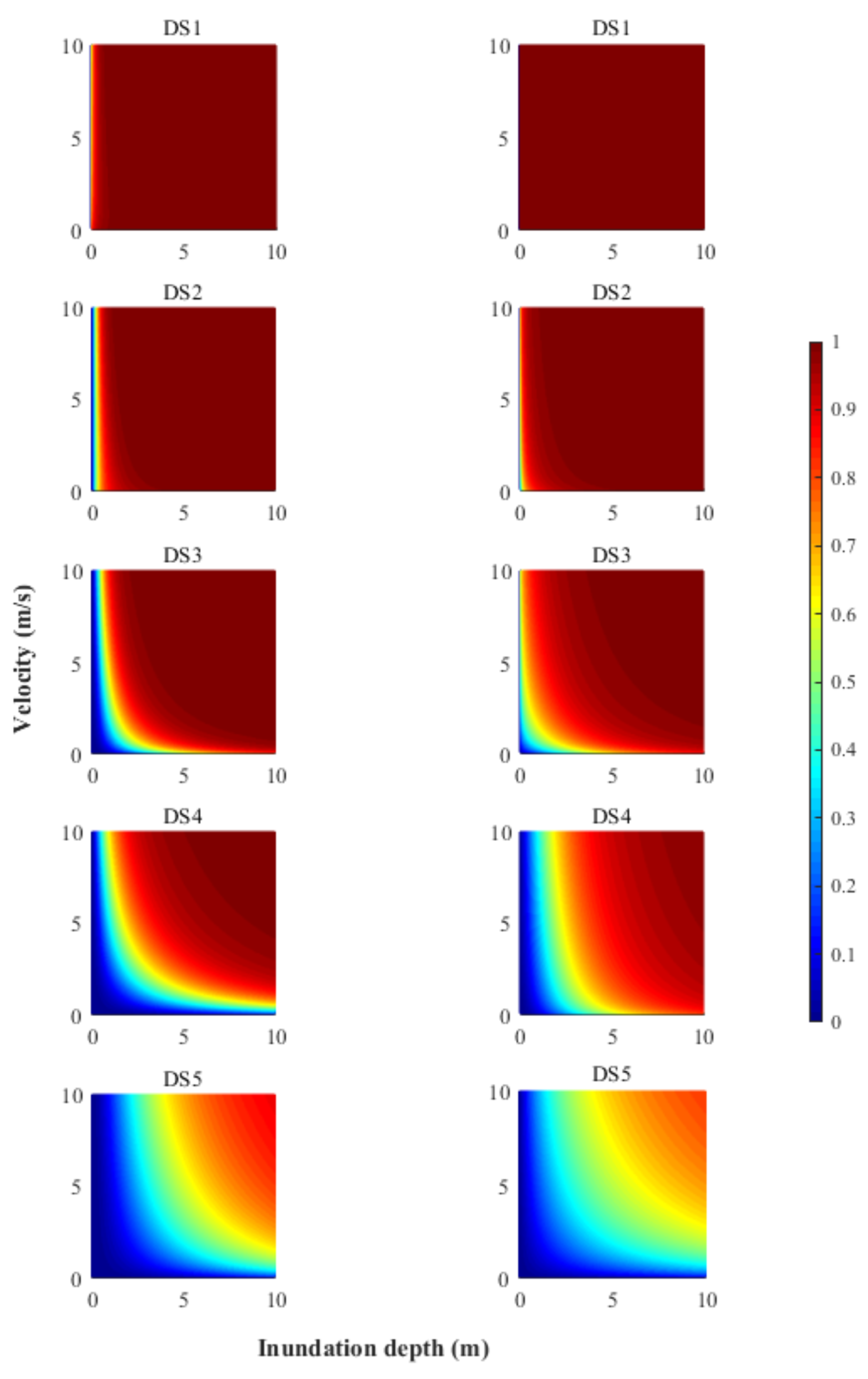

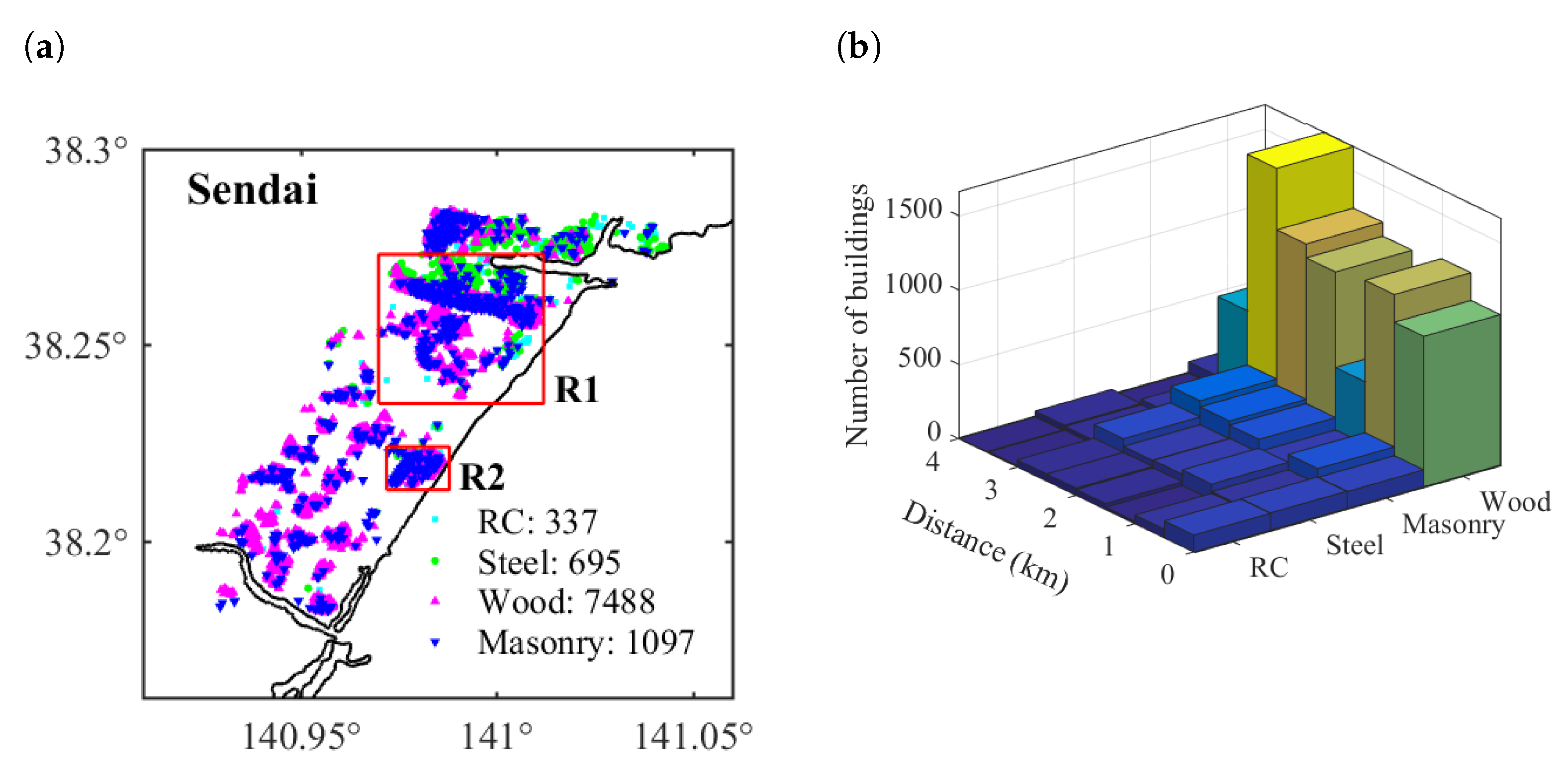
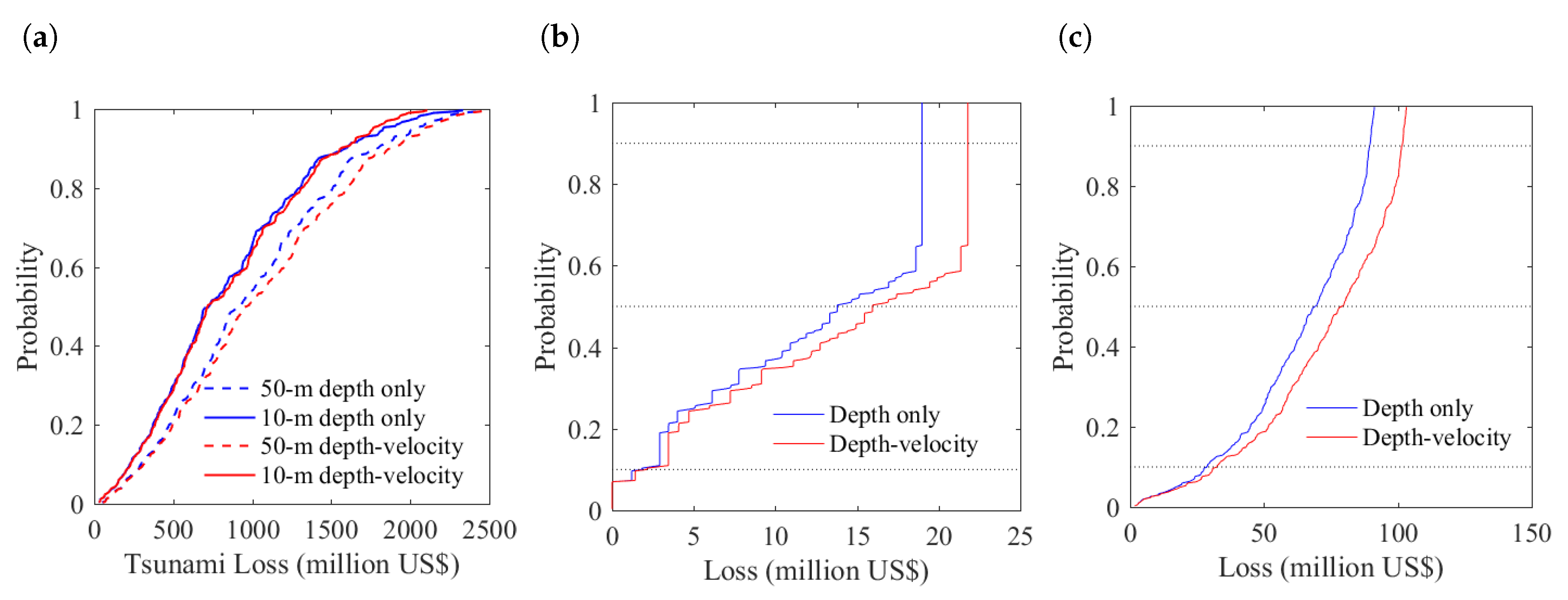
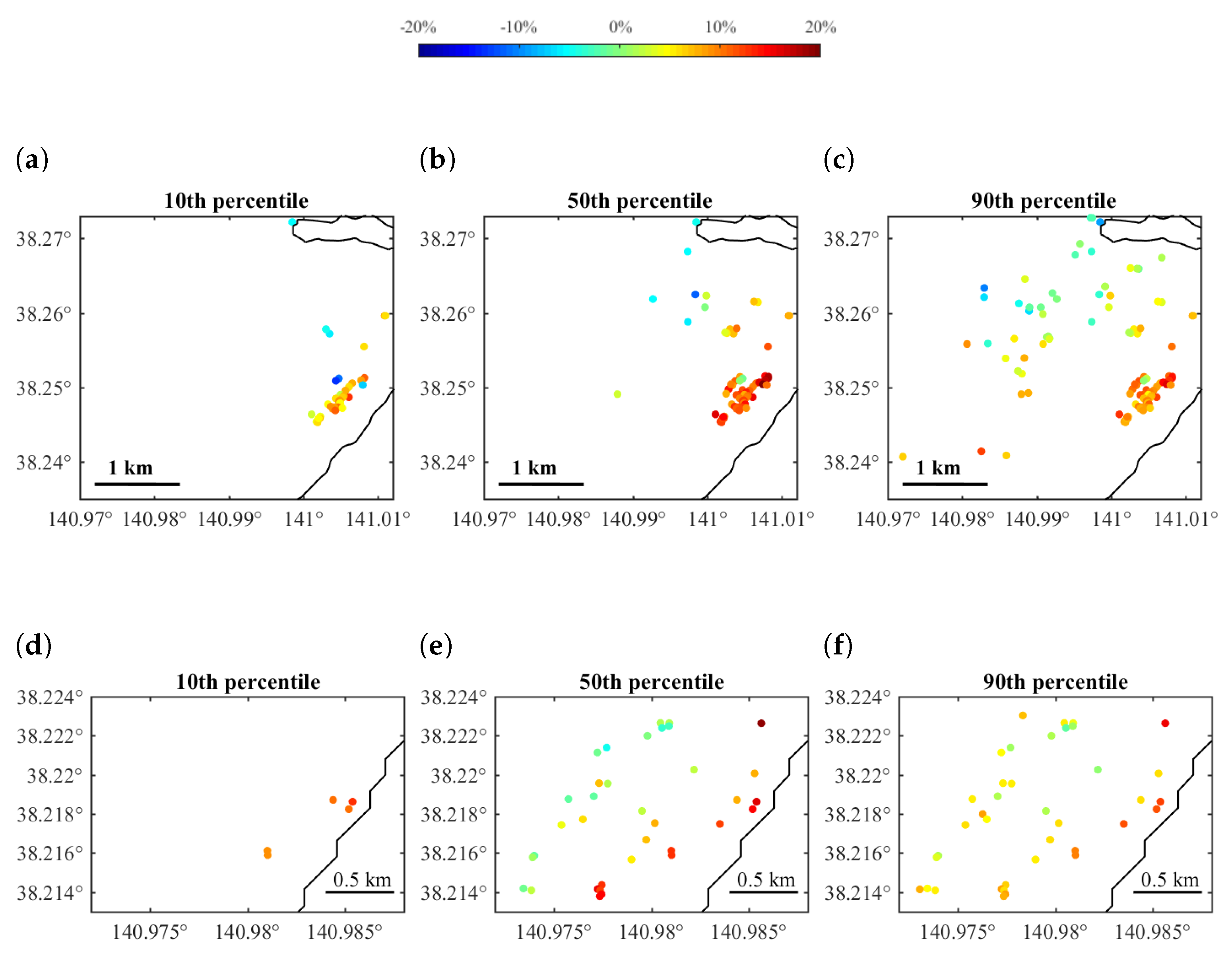
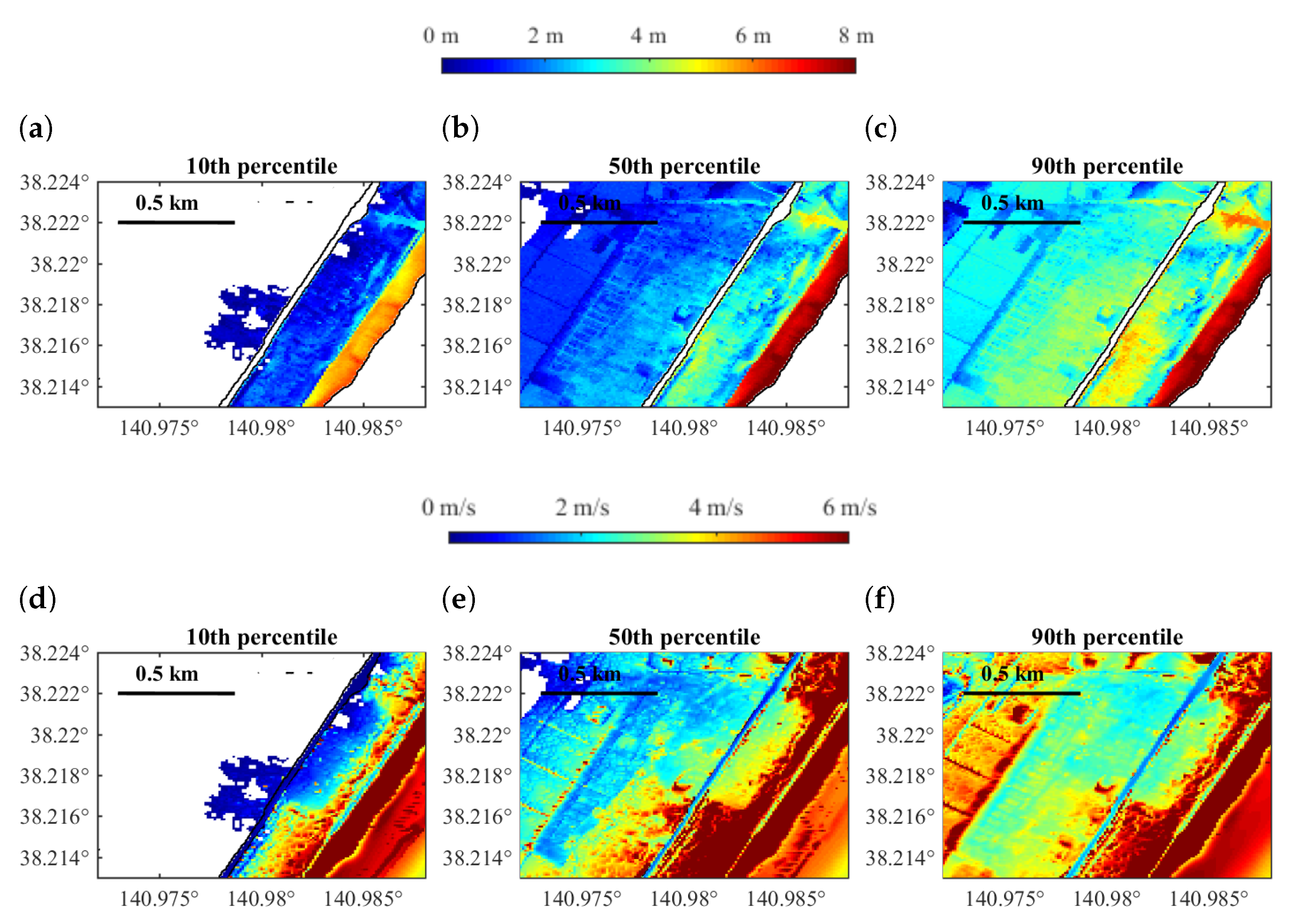


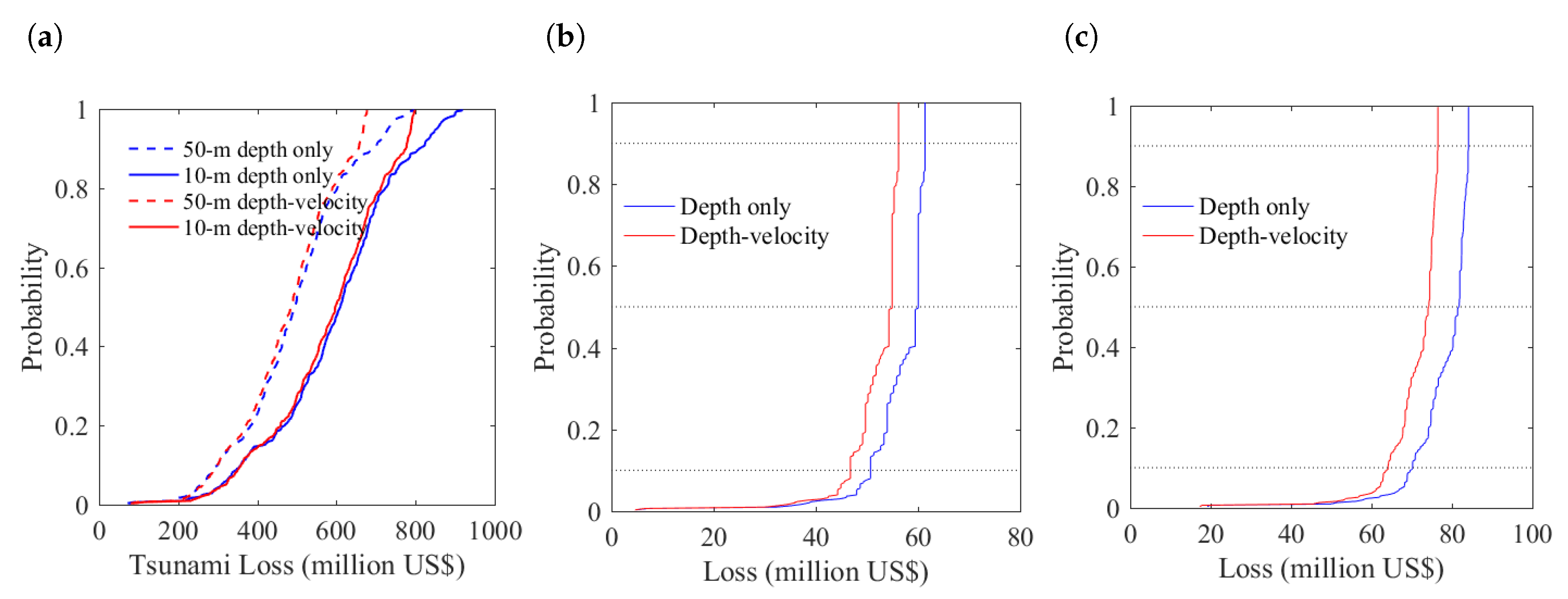
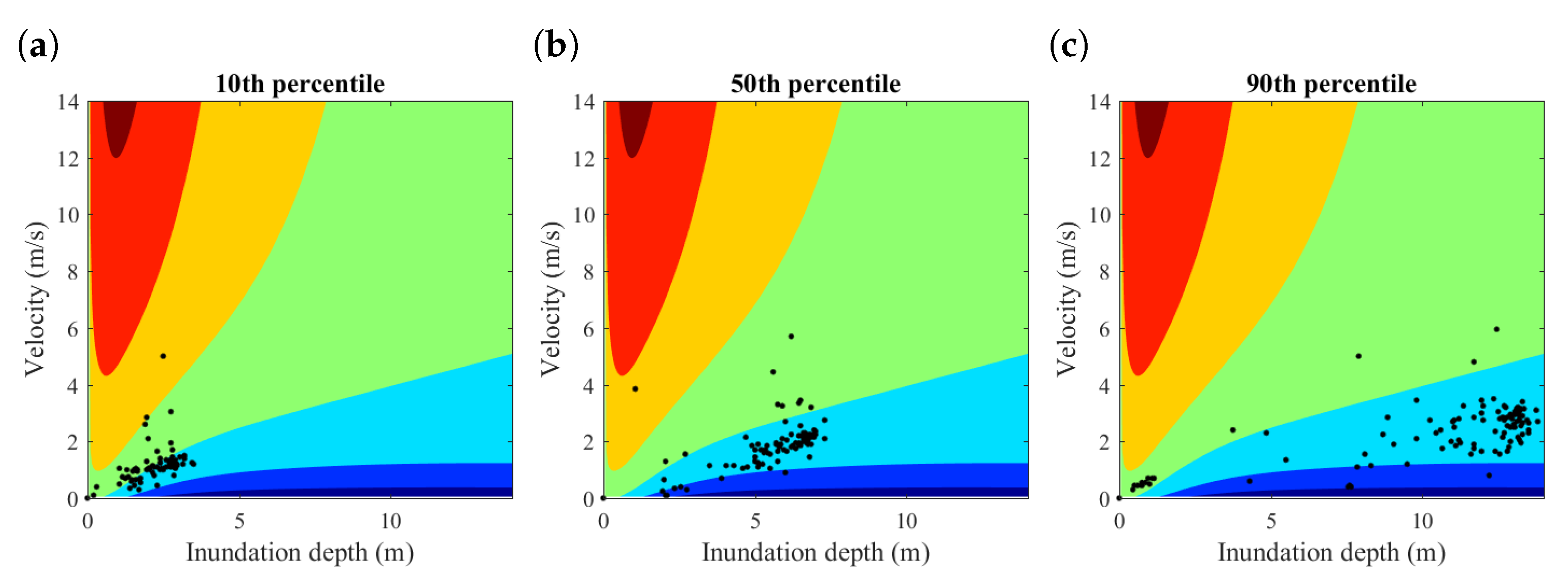

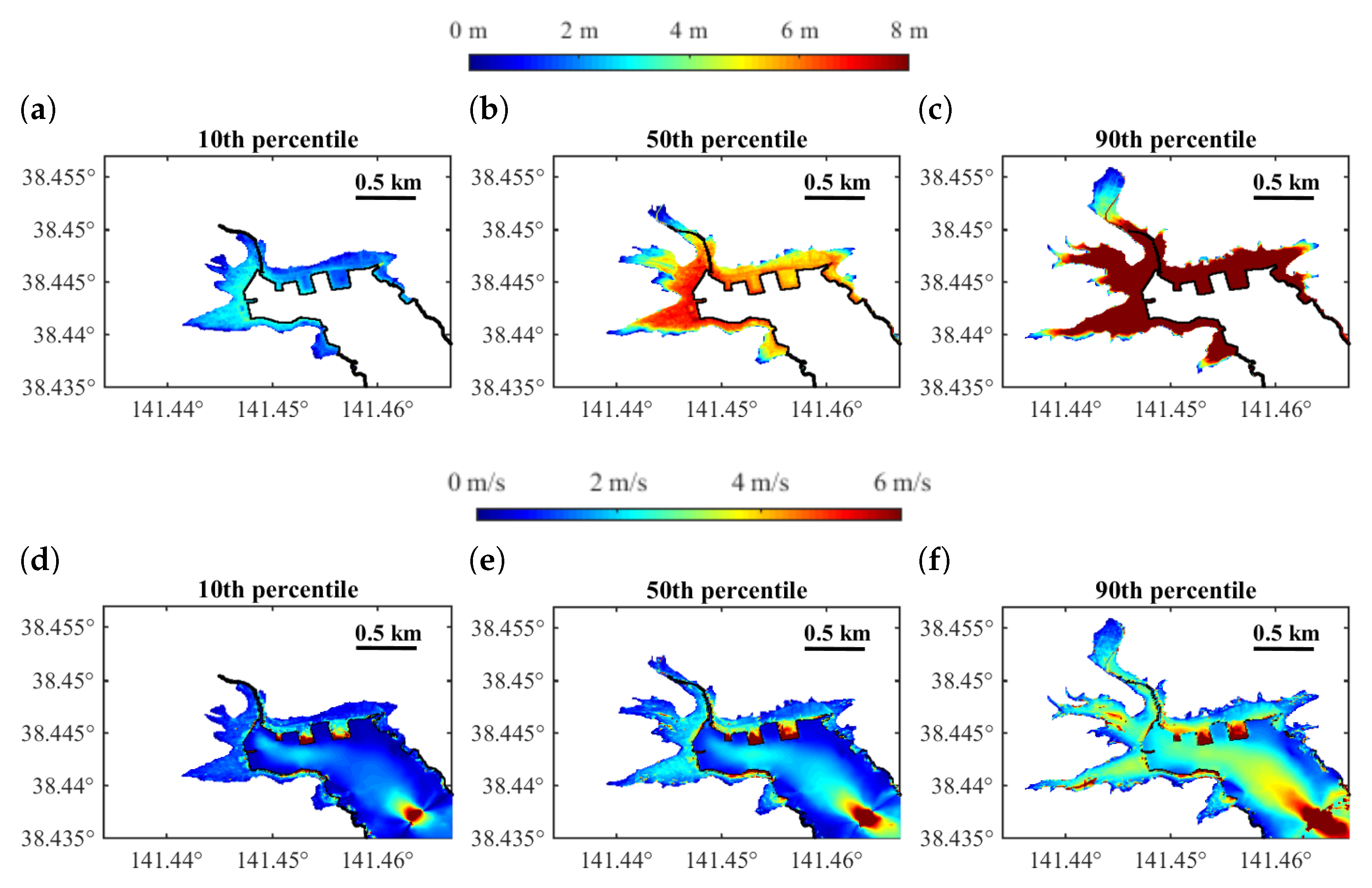
| Parameter | DS1 | DS2 | DS3 | DS4 | DS5 |
|---|---|---|---|---|---|
| 1.54 | 1.43 | ||||
| 0.105 | 0.924 | 1.65 | 2.299 | 1.557 | |
| 0.186 | 0.768 | 0.738 | |||
| 0.023 | 0.437 | 0.215 | |||
| 0.169 | 0.213 | 0.696 | |||
| 0.058 | 0.906 | 2.023 | |||
| 0.108 | 0.27 | 1.486 | 1.16 | ||
| 0.319 | 0.878 | 0.354 |
| Parameter | Plain Coast | Ria Coast | ||||||||
|---|---|---|---|---|---|---|---|---|---|---|
| DS1 | DS2 | DS3 | DS4 | DS5 | DS1 | DS2 | DS3 | DS4 | DS5 | |
| 1.795 | 1.742 | 81.396 | 1.685 | |||||||
| 0.307 | 1.355 | 1.925 | 1.564 | 1.701 | 1.638 | 0.827 | 0.458 | 1.774 | 1.063 | |
| 1.105 | 0.548 | 0.459 | 0.432 | |||||||
| 0.754 | 0.144 | 105.544 | 0.767 | 1.039 | ||||||
| 0.406 | 0.589 | 21.37 | 0.223 | 0.486 | 0.849 | |||||
| 1.415 | 2.001 | 0.052 | 0.976 | 1.47 | 2.491 | |||||
| 0.375 | 1.263 | 0.088 | 0.808 | 2.09 | 0.595 | |||||
| 1.152 | 0.296 | 0.776 | 0.702 | 1.73 | 0.304 | |||||
| 0.782 | 1.604 | 0.850 | 0.004 | 0.767 | 0.234 | 0.773 | ||||
© 2017 by the authors. Licensee MDPI, Basel, Switzerland. This article is an open access article distributed under the terms and conditions of the Creative Commons Attribution (CC BY) license (http://creativecommons.org/licenses/by/4.0/).
Share and Cite
Song, J.; De Risi, R.; Goda, K. Influence of Flow Velocity on Tsunami Loss Estimation. Geosciences 2017, 7, 114. https://doi.org/10.3390/geosciences7040114
Song J, De Risi R, Goda K. Influence of Flow Velocity on Tsunami Loss Estimation. Geosciences. 2017; 7(4):114. https://doi.org/10.3390/geosciences7040114
Chicago/Turabian StyleSong, Jie, Raffaele De Risi, and Katsuichiro Goda. 2017. "Influence of Flow Velocity on Tsunami Loss Estimation" Geosciences 7, no. 4: 114. https://doi.org/10.3390/geosciences7040114





